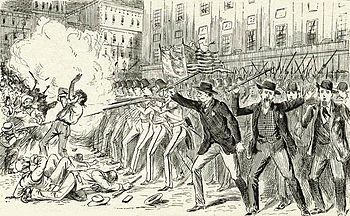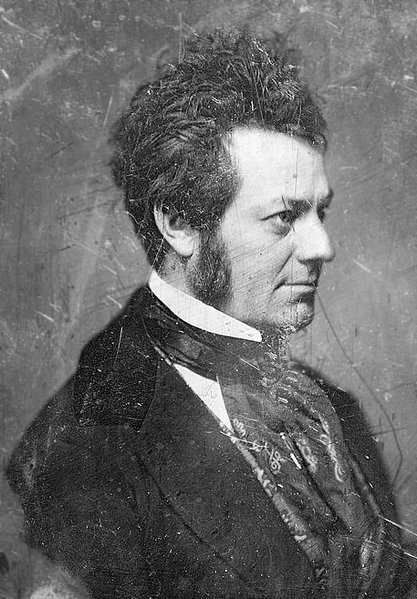 |
| At least 22 New Yorkers were killed -- over Shakespeare. |
Astor Place Theater Riot, 1849
It all started as a rivalry between two Shakespearean actors. Before it was over, at least 22 New Yorkers would be dead and more than 230 injured.Edwin Forrest was a leading American Shakespearean actor in the 19th century. In fact, he may be said to have been the first real American star of the theater. During the same period, William Charles Macready, an English Shakespearean actor, had his own following. The two actors had somewhat different styles of acting: Forrest tended to be physical and bombastic, while Macready tended to be more subdued and refined. Both actors toured in both England and the United States, and had started out with friendly attitudes toward each other.
The trouble seemed to have started when Forrest made his second visit to England in 1845. His first London performances in various roles were well received, but when he acted the role of Macbeth, the audience hissed him. He blamed this incident on Macready, believing that he had undermined Forrest's popularity. A few weeks later, Forrest attended a Macready's performance of Hamlet and stood up and hissed the English actor. From here things only got worse.
 |
| Forrest was popular with the working class. |
In May 1849, Macready was scheduled to play the part of Macbeth at the Astor Place Opera House, an upper-class establishment in New York City. Forrest arranged to present a competing Macbeth at the Bowery Theater, which was not far away. The Bowery Theater, however, catered to a less elite crowd. At this time, Shakespeare was very much the entertainment choice of all classes in America. It was only later -- after the Astor Place Riot, in fact -- that it would be considered an entertainment only for highbrows.
Forrest was very much connected to the working man. His fans were of the working class, and he had associations with the gangs that were operating in New York at that time. On May 7th, 1849, Forrest's supporters attended Macready's performance in full force. Hundreds of them attended, all seated in the upper rows of the Opera House, and all carrying a full arsenal of rotten eggs, fruit and vegetables, shoes, and vile-smelling liquids.
When Macready appeared on stage, he was pelted with the debris. All the performers were drowned out by hissing, boos, and various catcalls, but performed the play in pantomime, since they could not make themselves heard. When it was over, Macready was ready to leave for England immediately, but his supporters persuaded him to stay for another performance, bringing him a petition of 47 names, all prominent New Yorkers. Among the signatures were Herman Melville and Washington Irving.
 |
| Macready was popular with the upper class. |
By this point, it wasn't just about Shakespeare anymore. Mayor Woodhull was a newly-elected Whig, and the Tammany Hall leaders were determined to embarrass him. There was also conflict between the wealthy and the working class and between the Irish immigrants and the native-born. There was also a good deal of anti-British jingoism that came into play.
By the time the play started there were 10,000 people in the street outside the Opera House. The Forrest supporters pelted the building with stones and debris, and altercated with the police. There was even an attempt to set fire to the theater, which failed, possibly because the police barred most of the pro-Forrest ticketholders from entering the building.
The militia was then called in. They were attacked by the mob, just as the police had been. They warned, then they fired into the air, and then they fired into the crowd -- at point-blank range. Somewhere between 22 and 31 individuals were killed, some of them innocent bystanders. At least seven of the dead were Irish immigrants. At least 48 citizens were injured, along with 50 to 70 policemen and approximately 140 militia.
As a result of the Opera House riots, the city became even more polarized by class differences. In the world of entertainment, Shakespeare began to become more regarded as a "highbrow" activity, and the working classes gravitated more toward vaudeville, burlesque, and minstrel shows. Forrest's reputation was severely damaged by the event, and Macready never returned to America again. The Astor Opera House, now popularly known as "Massacre Opera House," never regained its popularity and became the New York Mercantile Library. A new venue, the Academy of Music, was opened in 1854. It was located farther uptown, away from the working-class district.
No comments:
Post a Comment